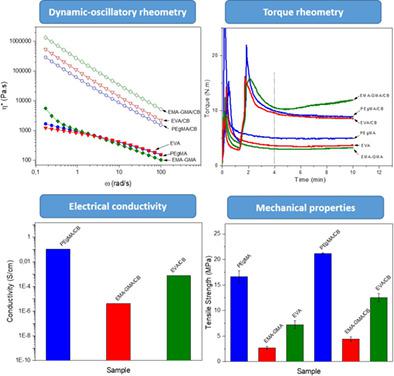当前位置:
X-MOL 学术
›
J. Vinyl Addit. Technol.
›
论文详情
Our official English website, www.x-mol.net, welcomes your
feedback! (Note: you will need to create a separate account there.)
Electrical, rheological, and mechanical properties copolymer/carbon black composites
Journal of Vinyl and Additive Technology ( IF 3.8 ) Pub Date : 2021-02-17 , DOI: 10.1002/vnl.21818 Amanda M. Alves 1 , Shirley N. Cavalcanti 1 , Moacy P. Silva 1 , Daniel M. G. Freitas 1 , Pankaj Agrawal 1 , Tomás J. A. Mélo 1
Journal of Vinyl and Additive Technology ( IF 3.8 ) Pub Date : 2021-02-17 , DOI: 10.1002/vnl.21818 Amanda M. Alves 1 , Shirley N. Cavalcanti 1 , Moacy P. Silva 1 , Daniel M. G. Freitas 1 , Pankaj Agrawal 1 , Tomás J. A. Mélo 1
Affiliation

|
This work aims to evaluate the electrical conductivity and the rheological and mechanical properties of copolymer/carbon black (CB) conductive polymer composites (CPCs). The copolymers, containing ethylene groups in their structure, used as matrix were polyethylene grafted with maleic anhydride (PEgMA), ethylene‐methyl acrylate–glycidyl methacrylate (EMA‐GMA), and ethylene‐vinyl acetate (EVA). For comparison purposes, bio‐based polyethylene (BioPE)/CB composites were also studied. The electrical conductivity results showed that the electrical percolation threshold of BioPE/CB composite was 0.36 volume fraction of CB, whereas the rheological percolation threshold was 0.25 volume fraction of CB. The most conductive CPC was BioPE/CB. Among the copolymer/CB CPCs, PEgMA/CB showed the highest conductivity, which can be attributed to the fact that the PEgMA copolymer had higher crystallinity. It also has a higher amount of ethylene groups in its structure. Torque rheometry analysis indicated that EMA‐GMA copolymer may have reacted with CB. Rheological measurements under oscillatory shear flow indicated the formation of a percolated network in BioPE/CB and copolymer/CB composites. Morphology analysis by scanning electron microscopy (SEM) indicated the formation of a percolated network structure in BioPE/CB composite and finely dispersed CB particles within the PEgMA copolymer. Wetting of CB particles/agglomerates by the copolymer matrix was observed in EVA/CB and EMA‐GMA/CB composites. Conductive CB acted as reinforcing filler as it increased the elastic modulus and tensile strength of BioPE and the copolymers.
中文翻译:

共聚物/炭黑复合材料的电,流变和机械性能
这项工作旨在评估共聚物/炭黑(CB)导电聚合物复合材料(CPC)的电导率以及流变和机械性能。将结构中含有乙烯基团的共聚物用作基质,将聚乙烯与马来酸酐(PE g MA),乙烯-丙烯酸甲酯-甲基丙烯酸缩水甘油酯(EMA-GMA)和乙烯-乙酸乙烯酯(EVA)接枝。为了进行比较,还对生物基聚乙烯(BioPE)/ CB复合材料进行了研究。电导率结果表明,BioPE / CB复合材料的电渗流阈值为CB的0.36体积分数,而流变渗流阈值为CB的0.25体积分数。导电性最高的CPC是BioPE / CB。在共聚物/ CB CPCs中,PE gMA / CB表现出最高的电导率,这可以归因于PE g MA共聚物具有更高的结晶度。它还在其结构中具有较高数量的亚乙基。扭矩流变分析表明EMA-GMA共聚物可能与CB反应。在振荡剪切流下的流变学测量表明在BioPE / CB和共聚物/ CB复合材料中形成了渗滤网络。扫描电镜(SEM)的形态分析表明,在BioPE / CB复合材料中形成了渗滤网络结构,并且PE g中的CB颗粒细分散MA共聚物。在EVA / CB和EMA-GMA / CB复合材料中观察到共聚物基质对CB颗粒/附聚物的润湿。导电炭黑起增强填料的作用,因为它可以提高BioPE及其共聚物的弹性模量和拉伸强度。
更新日期:2021-02-17
中文翻译:

共聚物/炭黑复合材料的电,流变和机械性能
这项工作旨在评估共聚物/炭黑(CB)导电聚合物复合材料(CPC)的电导率以及流变和机械性能。将结构中含有乙烯基团的共聚物用作基质,将聚乙烯与马来酸酐(PE g MA),乙烯-丙烯酸甲酯-甲基丙烯酸缩水甘油酯(EMA-GMA)和乙烯-乙酸乙烯酯(EVA)接枝。为了进行比较,还对生物基聚乙烯(BioPE)/ CB复合材料进行了研究。电导率结果表明,BioPE / CB复合材料的电渗流阈值为CB的0.36体积分数,而流变渗流阈值为CB的0.25体积分数。导电性最高的CPC是BioPE / CB。在共聚物/ CB CPCs中,PE gMA / CB表现出最高的电导率,这可以归因于PE g MA共聚物具有更高的结晶度。它还在其结构中具有较高数量的亚乙基。扭矩流变分析表明EMA-GMA共聚物可能与CB反应。在振荡剪切流下的流变学测量表明在BioPE / CB和共聚物/ CB复合材料中形成了渗滤网络。扫描电镜(SEM)的形态分析表明,在BioPE / CB复合材料中形成了渗滤网络结构,并且PE g中的CB颗粒细分散MA共聚物。在EVA / CB和EMA-GMA / CB复合材料中观察到共聚物基质对CB颗粒/附聚物的润湿。导电炭黑起增强填料的作用,因为它可以提高BioPE及其共聚物的弹性模量和拉伸强度。











































 京公网安备 11010802027423号
京公网安备 11010802027423号